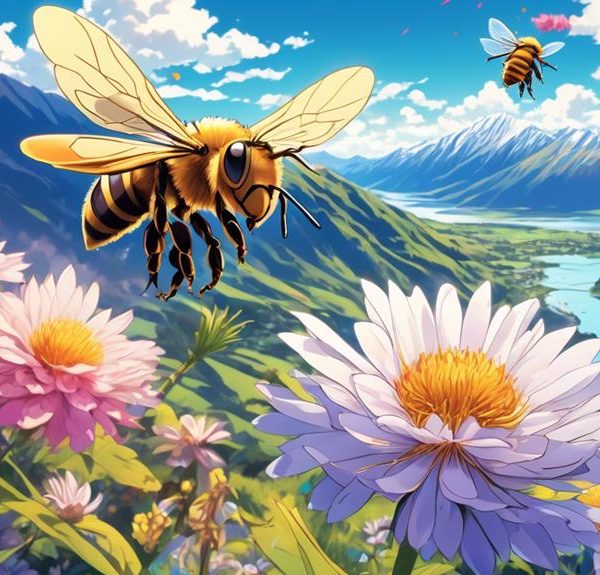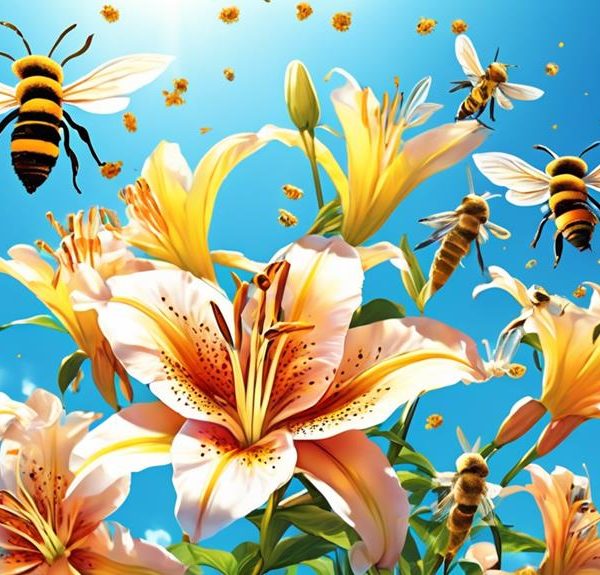Learn the fascinating intricacies of the relationship between bees and wisteria, a tale of attraction and survival that's not as straightforward as it seems.
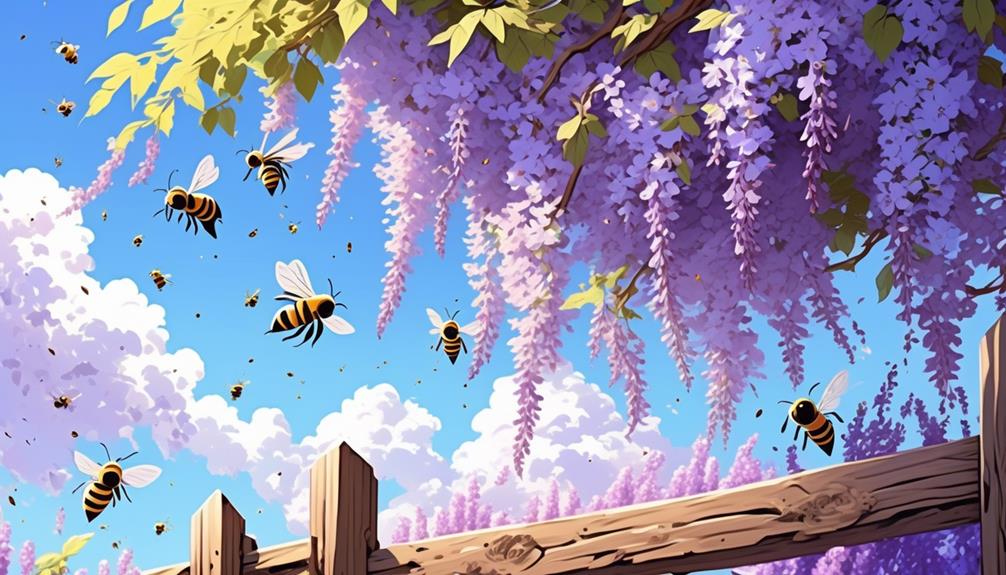
Do Bees Like Wisteria?
You've likely heard the phrase 'busy as a bee,' but have you ever wondered what exactly keeps these industrious insects so occupied? Specifically, let's consider their relationship with the wisteria plant.
Wisteria, with its cascading clusters of purple flowers, is undeniably attractive… but does it hold the same allure for bees? This isn't a simple yes or no question. The answer depends on a variety of factors, including the type of bee and the specific characteristics of the wisteria plant in question.
So, let's peel back the petals of this topic and explore what's really buzzing between bees and wisteria.
Key Takeaways
- Bees are attracted to wisteria due to its sweet fragrance, purple-blue hues, and nectar-rich flowers.
- Bees play a crucial role in the pollination of wisteria, ensuring its reproduction and seed production.
- Wisteria can positively impact local bee populations by providing a significant nectar source.
- However, wisteria's invasive nature and timing of bloom can have negative effects on bee populations and disrupt native plant pollination.
Understanding Bee Attraction Factors
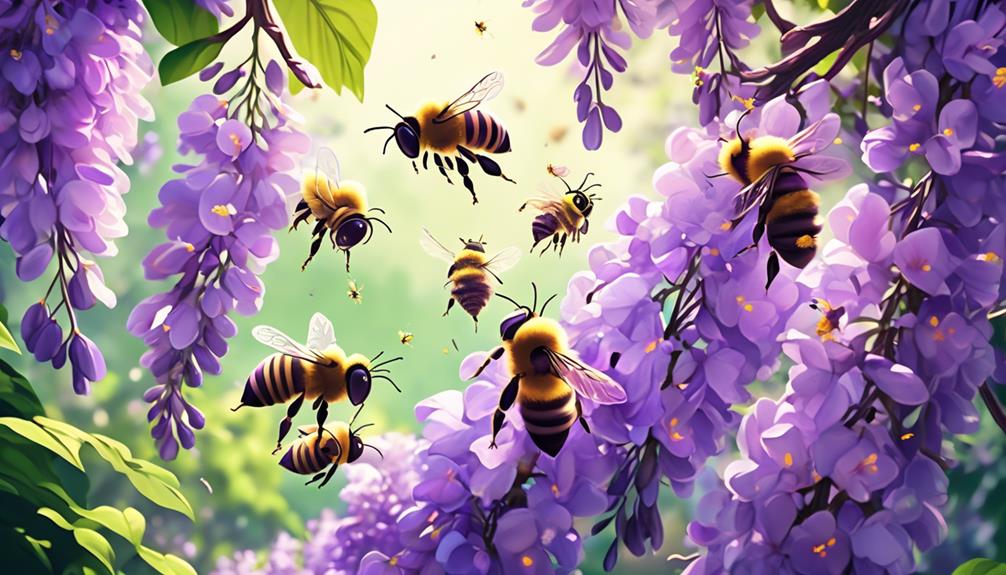
To fully grasp why bees are so attracted to wisteria, you'll need to delve into specific factors such as scent, color, and nectar production.
Bees have an acute sense of smell, which they use to locate flowers with nectar. Wisteria's sweet, intoxicating fragrance serves as a powerful attractant for these tiny creatures.
Color plays a significant role as well. Bees can see colors, but not in the same way we do. They're particularly attracted to purple and blue hues. As it turns out, wisteria blossoms exhibit these colors in abundance, giving bees a visual beacon to follow.
Lastly, let's consider nectar production. Bees are in constant search of food, and nectar is their primary energy source. Wisteria is a nectar-rich plant, providing ample sustenance for bees. This, combined with the plant's prolific blooming habit, ensures a steady supply of food, making wisteria a veritable bee magnet.
In essence, wisteria's scent, color, and high nectar production work in harmony to attract bees. Understanding these factors provides a clearer picture of the symbiotic relationship between bees and wisteria, and why this attraction is vital for both parties.
Wisteria: A Brief Overview
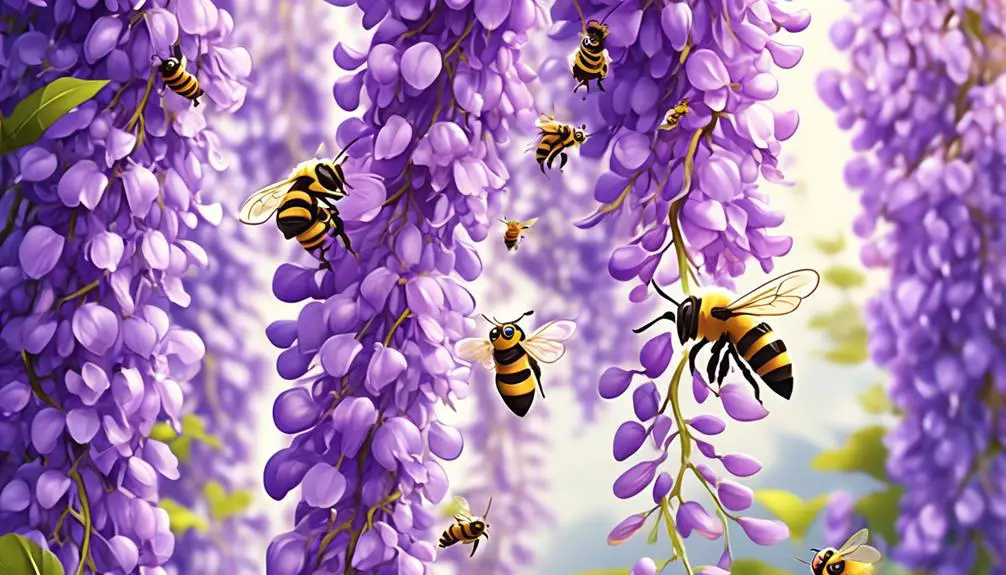
Having explored the allure of wisteria for bees, let's now turn our attention to the plant itself and provide a brief overview of its characteristics and growth habits.
Wisteria, a member of the pea family, is a deciduous climbing vine known for its cascading clusters of fragrant, purple-blue flowers. It's a hardy plant, able to tolerate a range of soil types as long as they're well-drained.
Wisteria can reach heights of over 20 meters, with a spread of up to 10 meters. The plant's growth habit is aggressive, often taking over other plants if it's not properly managed. It's a sun-loving plant, requiring at least six hours of direct sunlight each day for optimal growth and flower production.
The flowering process of wisteria is quite fascinating. It begins to bloom in late spring, with the flowers usually appearing before the leaves. The flowers, which come in shades of white, pink, and purple, are produced in long, pendulous racemes and have a sweet, pleasing fragrance.
The Relationship Between Bees and Wisteria
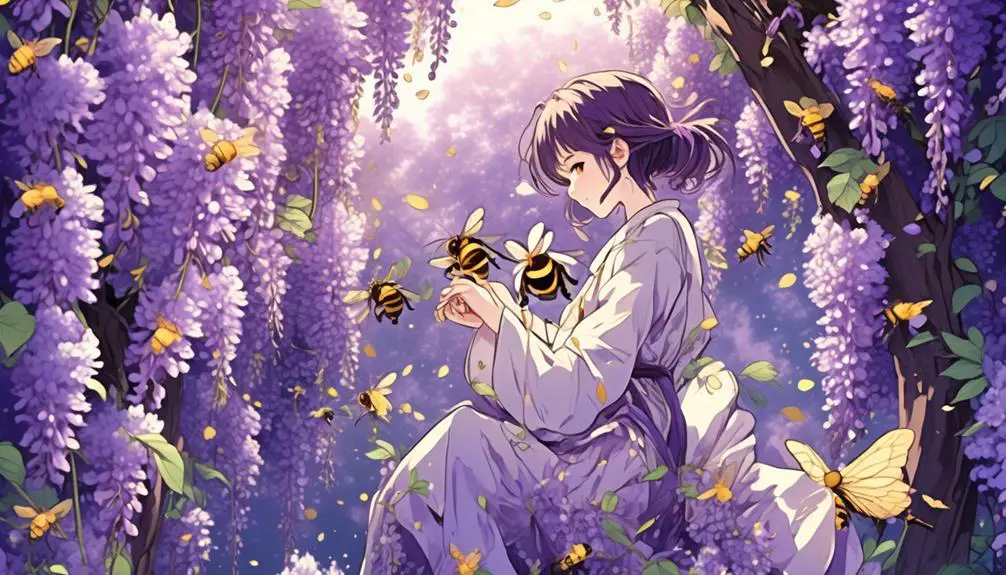
Bees, those industrious pollinators, find an irresistible feast in the cascading clusters of wisteria, establishing a symbiotic relationship that's crucial for the survival of both species. You see, bees seek out wisteria for its rich nectar, and in the process of feeding, they inadvertently collect pollen on their bodies which they then transfer to other flowers, aiding in their pollination.
This interaction is not simply a one-way benefit. Wisteria, in return, relies on bees to ensure its reproduction. Without bees, wisteria's capacity to produce seeds and ensure the continuation of the species would be significantly compromised.
To illustrate this relationship, let's consider the following table:
Bee Benefit | Wisteria Benefit | Relationship Type |
|---|---|---|
Rich nectar source | Pollination | Mutualistic |
Shelter in flower clusters | Seed production | Mutualistic |
Gathering pollen for honey production | Species propagation | Mutualistic |
In essence, the relationship between bees and wisteria is a perfect example of nature's interconnectedness, where one species' survival directly impacts the other. It's a delicate balance that emphasizes the importance of preserving both bees and vibrant species like wisteria in our ecosystems.
Impact of Wisteria on Local Bee Populations
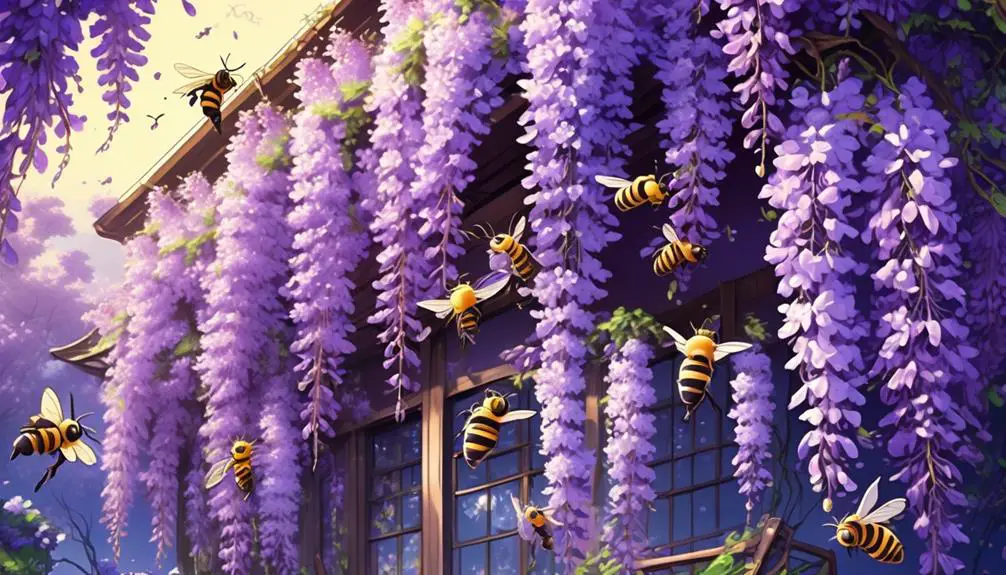
While understanding the mutualistic relationship between bees and wisteria provides a broader ecological context, let's now examine specifically how local bee populations are affected by the presence of wisteria in their habitat.
Wisteria, with its ample nectar supply, can significantly boost local bee populations. During wisteria's blooming season, you'll notice an uptick in bee activity as they're drawn to the rich nectar source. However, it's not all positive. Wisteria's invasive nature can lead to outcompeting native plant species, potentially reducing the diversity of nectar sources.
Moreover, the timing of wisteria's bloom can disrupt the bees' foraging patterns. Early blooming can draw bees away from pollinating other native plants that bloom at the same time. This shift can result in decreased pollination and reproduction of these native plants, further threatening biodiversity.
On the flip side, a late bloom can leave bees with a scarcity of nectar sources in the early spring, causing a drop in bee populations. It's clear that while wisteria can provide plentiful nectar, its presence in a habitat has complex and far-reaching impacts on local bee populations.
Balancing these impacts is crucial for maintaining a healthy and diverse ecosystem.
Steps to Attract Bees With Wisteria

If you're keen to attract bees using wisteria in your garden, there are several effective strategies you can implement. Wisteria is a bee-friendly plant, but its attractiveness to bees can be enhanced through strategic planting and maintenance.
Here's a guide to maximize your garden's bee-attracting potential:
Step | Action | Explanation |
|---|---|---|
1 | Plant in Sunlight | Wisteria needs full sun to bloom effectively; the more it blooms, the more bees it attracts. |
2 | Prune Regularly | Pruning encourages growth and helps maintain a healthy, blossom-rich plant. A well-pruned wisteria is irresistible to bees. |
3 | Avoid Pesticides | Bees are sensitive to pesticides. Use organic alternatives instead to keep your wisteria bee-friendly. |
The right placement and proper care of your wisteria can significantly boost its appeal to bees. Remember, bees are vital pollinators. Attracting them to your garden not only benefits the wisteria but also contributes to local ecosystems. So, you're not just growing a beautiful garden, you're also helping support the environment. It's a win-win situation for you and the bees!
Frequently Asked Questions
What Are Some Other Plants That Attract Bees?
You're curious about other plants that attract bees? Well, bees are drawn to a variety of flora. They'll flock to plants like lavender, foxgloves, and sunflowers.
Herbs such as rosemary and thyme are also bee favorites.
If you're into fruit, apple and cherry trees can draw bees in droves.
And don't forget about vegetables; squash and cucumber plants are quite appealing to bees as well.
They're not picky, as long as it's nectar-rich!
How Can I Safely Remove a Bee Hive From My Wisteria?
To safely remove a bee hive from your plant, never attempt it yourself. Bee removal can be dangerous. It's recommended to call a local beekeeper or a professional pest control service.
They'll have the right equipment and expertise to remove the hive without harming the bees or causing unnecessary damage to your plant.
Are There Types of Bees That Aren't Attracted to Wisteria?
Yes, there are certain bee species that aren't attracted to wisteria. While many bees are drawn to the plant's fragrant, nectar-rich blossoms, others may not be.
Species like the leafcutter and mason bees, for instance, prefer other types of plants. So, it's not a one-size-fits-all situation.
It's really about the specific preferences of the bee species in question, which can vary greatly.
How Does Wisteria Affect the Honey Produced by Bees?
When bees feed on wisteria, it impacts the honey they produce. The nectar from wisteria gives a unique, floral taste to the honey. You'll notice a light color, and a delicate, sweet aroma as well.
However, it's important to note that the flavor profile can vary, as bees often feed on various flowers. So, while wisteria does influence the honey's taste, it's typically part of a complex blend of flavors.
Can Wisteria Attract Other Insects Apart From Bees?
Yes, wisteria can attract a variety of insects apart from bees. It's not just bees that are lured by its rich nectar and vibrant colors. Butterflies, moths, and beetles are often seen buzzing around these plants.
However, you'll also want to watch out for harmful pests like aphids and scale insects, which can damage your wisteria. It's crucial to monitor the insects attracted to ensure the plant's health.
Conclusion
In conclusion, bees indeed love wisteria. The flowers' sweet scent and vibrant colors allure bees, providing them with an excellent nectar source.
Planting wisteria not only enhances your garden's beauty but also supports local bee populations, playing a crucial role in their survival.
So, if you're eager to attract bees, consider adding some wisteria. Remember, a thriving bee population means a healthier environment.

